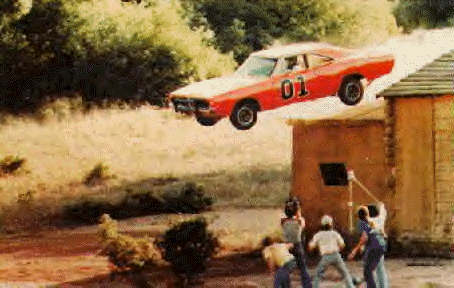
History About the Dukes of Hazzard:

History About the Dukes of Hazzard:
The Dukes of Hazzard was considered in the television genre of a "southern" relative to a Western. Each episode consisted of non-violent violence. This non-violent violence meant that there were no deaths, no blood, but yet there was some amazing vehicular mayhem.
The Dukes of Hazzard debuted on CBS in January of 1979 and became part of CBS' Friday night line up. The show remained part of the CBS Friday night line up until September of 1985. In September, it was then replaced by "Dallas".
The Dukes of Hazzard's audience pertained to young adults to adults. The car stunts appealed more to the younger viewers.
The Dukes' popularity was a great success. The show ranked number two rated series on television.
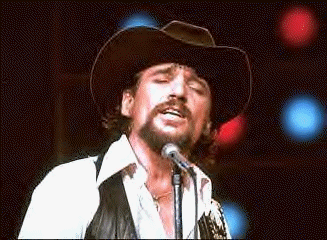
Each episode was witty narrated by the late country singer, Waylon Jennings. Although you wouldn't think such a simple-minded show would require a balladeer, his gifting story-telling abilities was one of many unique elements that made the show so classic. The classic themesong "Good Ol' Boys" which he composed and sung, hit #1 on the country charts in 1980. The Dukes' narrator Waylon Jennings just recently died from diabetes last week at his home.
History About the General Lee:
The General Lee, seen on the Dukes of Hazzard, is without question the most famous car on television today. As the Duke cousin's seemingly indestructible 1969 Dodge Charger, it has as many close brushes with the law, survives just as many hair-raising adventures, and stoically endures as much abuse as the Dukes themselves. The General Lee, however, is no mere automobile. Since the TV series began, it's become a true personality in its own right - so much so that car nuts in general and rabid Mopar buffs in particular watch the show as much to root for the General as for the Dukes behind the wheel. Indeed, the car is greatly responsible for the show's appeal, fast-paced action, and top-ten ratings success.
The inspiration for the hit TV series was a 1975 feature film written and directed by Gy Waldron. Called The Moonrunners, it was about a close-knit family determined to produce and sell its own moonshine despite stiff competition and federal agents. Waldron, who hails from the deep south, afterwards put together a proposal for a TV series loosely based on the characters and situations in the film, but cleaned up for television.
In discussions of the proposed series, Philip Mandelker and Paul Picard at Warner Bros. Television agreed that the Dukes should have a fast car, but not for the purpose of running moonshine. The car wouldn't be new either, but something more suited to the characters and their southern lifestyle. As you probably know, the southern states are the hotbed of stock-car racing, and one of the major NASCAR events, the Atlanta 500, is held at the Atlantic International Raceway in Georgia. And so it was decided that the General Lee - the name given the car in Waldron's proposal - was to be a race car pressed reluctantly into street service by the Dukes. But the specific make and model arrived only after lengthy deliberations.
The General Lee was painted a brillliant orange. It had the number 01 on the side of it, like a race car. The confederate flag was first considered for the hood, but later was moved to the roof.
The reason the Dukes of Hazzard crew chose the 1969 Dodge Charger was because it was aerodynamic for the jumps done in each episode. The first few Chargers to become General Lees were purchased straight off used-car lots for the filming in Georgia of the five pilot episodes. In case you may not know, there's no Hazzard County in Georgia. It was created for the show.
As for the General Lee's horn, it was discovered when some off the production crew, on their way to start shooting, passed a car with a horn that tooted the first 12 notes of Dixie. The film crew made an immediate 180-degree turn, pursued the car full of kids, and motioned to them to pull over. As Picard tells it: "Our people kept offering the kids money until they finally just opened the hood, pulled the horn out, and sold it to us." The horn, it turns out, is readily available through the J.C. Whitney catalog, but the crew wanted it right away for filming, since it was a natural for the General Lee.
Because of the car's age, every Charger is completely rebuilt from the ground up by Veluzat. All worn parts are replaced by new ones, the interior of each car is made to match that of its predecessors, and the car is ready to be turned over to the studio.
There were three or four General Lees set up for filming a show. And they always had two backups in case of breakdowns when they ran chase scenes.
The show goes through so many cars, of course, because of the spectacular stunts and jumps that draw viewers every week. From eight to ten hours are devoted to planning the chase sequences and leaps for each episode. Just how these are performed, however, is a closely guarded secret - and for good reason. Viewers are impressionable, the producers say, and they don't want them trying to duplicate the stunts performed on the show with the family car.
Fans of the show will be happy to know that much of the driving they see Bo (John Schneider) and Luke (Tom Wopat) doing is actually performed by them. Schneider, in fact, went to the Bob Bondurant School of High Performance Driving for just this purpose. The two actors are quite skilled at putting the General into controlled drifts and spins, and at stopping on a dime. However, whenever the General is due to leave the ground for any length of time, stunt doubles are called in. The studio can't afford to have its principal actors put out of commission by injuries - the more so because, unlike the numerous General Lees, which can be repaired or replaced quickly, there is only one John Schneider and one Tom Wopat.
The General Lee enjoys a tremendous
popularity among the younger viewers of the show, a fact which could very
well be due to the almost total lack of gutsy performance cars available
today, when even the ones you can buy are only sheep in wolf's clothing.
The General Lee, on the other hand, is no mealy-mouthed performance car,
but an unstoppable brute - a shining survivor of the muscle car's heyday.
Watching the Dukes outwit the corrupt Boss Hogg, viewers get the chance
to relive vicariously the days of sixties speed.
Facts About the Dukes' Racing Car:
"The General Lee"

Of the 85,000 or so 1969 Dodge Chargers sold by the Chrysler Corporation, over 300 were used in The Dukes of Hazzard. As told by the shows' stunt coordinator and former stunt driver, Paul Baxley: "Once a car has jumped, it's finished. The shock of the impact completely destroys the structural integrity of the car, even if there's no visible damage. We don't even drive a car on the show after it's been jumped. If the shot didn't come out right the first time, we do it again with another car."
The Cast
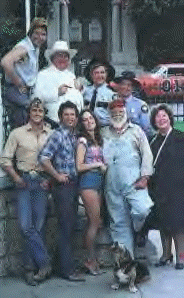
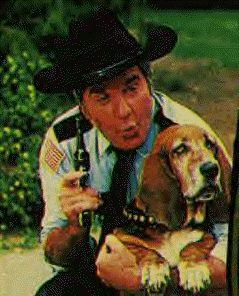
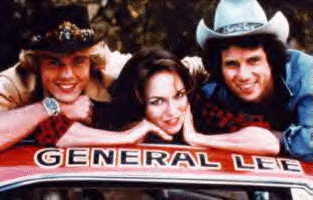
John Schneider played Bo Duke. Tom Wopat played Luke Duke and Catherine Bach played Daisy Duke. These three were the Duke cousins. The head of the Duke household was Uncle Jesse, who was played by Denver Pyle. Uncle Jesse died in 1997.
James Best played Sheriff Rosco P. Coltraine. Sheriff Rosco had a bassett hound named Flash that was always with him, no matter where he went. Sonny Shroyer played Deputy Enos Strate. Deputy Enos was in love with Daisy Duke. Rick Hurst played Deputy Cletus. Sorrell Booke played Boss Hogg. Boss Hogg died back in 1994.
And
Ben
Jones played Cooter, who was the Duke boys
good friend who always helped them fix the General Lee.
Summary of the Show
Each show was an hour long and was
set in the South. The show’s story line consisted of a pair of car-jockeying
cousins who delight in outwitting criminals and harassing the local police.
The show would always begin with some criminals trying to do some sort
of harm in Hazzard County. A majority of the time, Boss Hogg and Sheriff
Rosco P. Coltraine would be somehow wrapped up in the criminal activity.
The Duke boys would however come across the suspicious acts in their county
and try to rectify the situation. No matter how hard they tried to rectify
a situation, they some how always had the blame placed on them, so they
ended up running from the Hazzard County police almost the entire show.
The bad guys always got caught in the end.
Critical Reaction to the "Dukes'":
According to my research, the critics
and network executives hated. It was said that nobody liked, The Dukes
of Hazzard except for the viewers.
References:
"The Dukes of Hazzard." Biography. April 2000. Vol. 4, Issue4. 33-34.
"Dukes of Hazzard." Les Brown's
Encyclopedia of Television. 163-164.